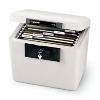jetsfan-24
Member
hey guys i,m looking two get a amsec bf 6636 whats everybody,s opinon of them i,m getting it four around 2400 dollars is that a good price ?
An opinion on the price or on the safe?any body else have an opinion ?
Second, as for that one being the best safe for your personal needs, I would need to know what drew you to that one before I could offer you an opinion.
AMSEC claims a 1275 degree / 90 minute fire rating on that safe which measures 65-1/4" x 36" x 26". As for something comparable, how about a Champion Triumph Series T40 which measures 66-1/4" x 38 x 27" 1/2" with a 1500 degree / 90 minute fire rating for $1,995.00?$2,400 is dirt cheap on that safe. That aside, what $2,400 safe is out on the market that offers the same/similar volume, security, and fire resistance?
AMSEC claims a 1275 degree / 90 minute fire rating on that safe which measures 65-1/4" x 36" x 26". As for something comparable, how about a Champion Triumph Series T40 which measures 66-1/4" x 38 x 27" 1/2" with a 1500 degree / 90 minute fire rating for $1,995.00?
What difference does it make if another safe passes the UL fire test when this AMSEC doesn't? A consumer has no choice but to compare apples and apples when only factory fire test results are listed by the manufacturer.Let's set the manufacturer's claims aside for a minute.
What is Champion using for insulation? Is there any UL rated safe on the market (one that has really passed a real fire test) using that same material?
AMSEC is using a material that is engineered to be a heat resistant safe insulation, and this same material is used in UL rated fire safes.
Unproven? Never used in the industry? Which industry is that?My point is one material is proven, and used often in the industry. The other material is unproven, never designed for the task at hand, and never used in the industry.
Although it's not visible, most safes have cheap residential grade quality locks, but the Group 2 combo boxes will out perform any residential grade lock box and are designed to last generations.
Unproven? Never used in the industry? Which industry is that?
If you want to talk about fireboard aka gypsum board aka sheetrock, it is the industry standard where gun safes are concerned.
No, it wasn't originally engineered to be used as insulation in a gun safe, but neither was concrete.
Again, I fail to see your point. Bottom line is, the BF Series of AMSEC is not UL listed for fire resistance.
I've seen photos of safe interiors after house fires on Liberty's site, Sturdy Safe's site, and Fort Knox's site, and they all have safes that held up well in house fires.
But one thing I've learned is that the minutes/degrees claimed by manufacturers, including the Amsec BF series (what the heck is a "Mercury Rating"?) are just not comparable. A U.L. test is only directly comparable to another U.L. test, and Omega Point labs test is only directly comparable to another Omega Point Labs test, etcetera. But none of their 'ratings' are directly comparable to each other. You have to have the temperature vs. time graph for the tests if they are from different outfits and you want to do any kind of comparison at all.
but is there much practical difference?

Concrete? Doesn't sound so high tech now.AMSEC is using a material that is engineered to be a heat resistant safe insulation, and this same material is used in UL rated fire safes.
Concrete? Doesn't sound so high tech now.
Many folks can't afford $3000-$4000 for the safe you sell.

